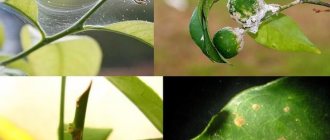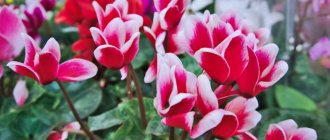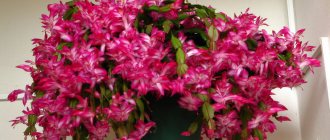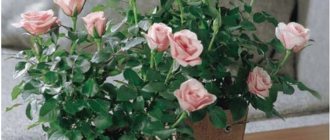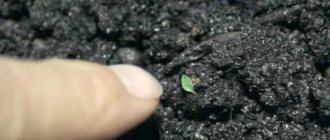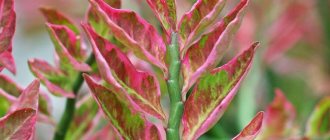Photo Nematanthus is a decorative shrub from the Gesneriaceae family. The shoots of a young plant point upward; in adulthood they become heavy and droop down. Under natural conditions, plants are distributed in the tropical zones of Colombia, Chile, Uruguay, and the homeland of Nematanthus is Brazil. The perennial plant develops quickly, the length of drooping shoots can reach at least 0.3 m.
It is not difficult to grow the nematanthus subshrub at home. It blooms all summer, forming many small tubular flowers that look like golden fish. Previously, the genus Hypocyrta and the genus Nematanthus were considered separate genera of the same family. According to the modern classification, they are combined, but sometimes Nematanthus continues to be called hypocyrta, although the name is considered outdated.
Be sure to pay attention to such wonderful plants as Achimenes and Columnea.
| The growth rate is high. |
| Blooms all summer, producing many small tubular flowers that look like goldfish |
| The plant is easy to grow. |
| It is a perennial plant. |
Appearance
Nematanthus flower grows in the Amazon forests, which are characterized by high humidity. The leaves of the plant are dark green, egg-shaped or elliptical, sometimes they have bluish veins. The length of the specimen is from 30 to 100 mm. The underside of the leaves is soft and may have a purple tint.
Nematanthus - South American exotic flower
Nematanthus gregarius has unusually shaped flowers. There are several types of plants, each of them differs in the color of the buds. In the jungle it blooms only in summer. At home, flowering time can last from March to November.
The flowers of the plant look like aquarium fish
Important! There is a sign associated with the plant. It is believed that in the house where it blooms, joy and prosperity will always be present.
General information
According to the reference book “All about Houseplants” by Dr. D. G. Hession, an English botanist: “Hypocyrta glabra (Hypocyrta glabra) prefers high humidity. The stems are erect or gracefully drooping, and orange, waxy flowers appear in summer. Hypocyrta nummularia (Hypocyrta monetata) is a hanging plant.”
Numerous flowers of Nematanthus (Hypocyrtus) look like small goldfish. This is a beautiful bushy plant with shiny dark green succulent leaves. The lower part of the leaf is painted burgundy, which gives the indoor plant additional charm.
Nematanthus is a liana. Nematanthus species with pubescent foliage curl less, so they are used in arrangements as cascading specimens.
Varieties
Oncidium: home care and flower varieties
Nematanthus Goldfish has approximately 35 species. About 7-8 of them are grown at home around the world:
- The most spectacular is Nematanthus Gregarius. This is what they call the Goldfish. Best suited for pots. Beautifully flowing vines will appeal to all lovers of the unusual.
- Prirechny. The species has large leaves, approximately 10 cm in length. The flowers are lemon yellow. The pharynx is unfolded, which is uncharacteristic of most nematanthus.
- View of Wetstein. The leaves are small and oval in shape. Their surface is smooth, wax-like. It produces shoots in the form of vines that can reach a meter. The flowers are tubular, red-orange or yellow, 25 mm long.
- Nematanthus Tropicana. It has large flowers in the shape of water lilies of yellow-orange color.
- Santa Teresa is a unique and almost uncommon species. The length of the flowers reaches 50 mm. The predominant color is cream or white. There are yellow spots on the surface.
- Variegated nematanthus are worth highlighting separately. Their occurrence is due to genetic mutations due to insufficient production of chlorophyll by leaves. Nematanthus hybrid looks extremely beautiful.
- Nematanthus Golden West. It has thick leaves with a creamy yellow outline. The color of the flowers is red-orange.
Nematanthus Tropicana - a beautiful plant
There are other types of Nematanthus. They all differ in the shape of the leaves and the color of the flowers.
Types of Nematanthus domestica with photos and names
In nature, there are 35 species of nematanthus. Only a few of them are common in indoor culture.
Nematanthus nummularia
The plant is ampelous. The diameter of light green rounded leaves is up to 20 mm. Small flowers are scarlet with a golden bend. Having completed flowering, the plant sheds its leaves.
Nematanthus gregarius Nematanthus gregarius
Glossy dark emerald leaves are small. Golden-red flowers look like small fish. This species is called Goldfish.
Nematanthus naked Nematanthus glabra
The fleshy, bright green leaves are distinguished by their elongation (up to 40 mm) and gloss. Up to 3 bright orange flowers are formed in their axils. Semi-ampelous plant.
Nematanthus wettsteinii
A plant with branching thin shoots elongated to 0.9 m. Dark green oval leaves are covered with a light waxy coating. The red-orange flowers are small (up to 2.5 cm), tubular. It is grown as an ampel plant in a hanging container.
Nematanthus will diversify any interior and emphasize its elegance. Maybe the plant will not attract “golden showers”, as the belief promises, but it will certainly lift your spirits with its original appearance.
Features of care
Types of zephyranthes flower - home care
The plant will not exist on its own. Care for nematanthus must be thorough. Everything will have to be taken into account: fertilizing, watering, lighting. It is not difficult to create the required conditions, but they are constantly maintained.
Temperature
When flowering, the plant should be kept in a room with a temperature of 19 to 24 degrees. In winter, 17 degrees will be enough, since the gregarius is at rest. Due to excessively high or low temperatures, the plant will begin to die.
Lighting
The ideal option for an indoor nematanthus flower is bright, diffused light. The plant will be comfortable on a windowsill located in the eastern or western part of the room. Due to lack of light, it will stop blooming. For this reason, the flower is illuminated using a phytolamp.
Watering
When Nematanthus gregarius radicans blooms, watering should be regular and abundant. In winter it is reduced. Water for irrigation is taken at room temperature. In the case of growing a species with large leaves, provide limited watering. If there is not enough water, the leaves curl and fly off.
For additional lighting use a phytolamp
Spraying
At every time of the year (except winter) the flower needs to be moistened - sprayed. To do this, take warm water. If cold weather sets in, the bush does not need additional moisture.
Humidity
The optimal humidity in the room should be 50%. If the temperature in the room is high, then the humidity should be increased. This nuance should not be overlooked.
Priming
When growing hypocyrtus nematanthus, loose soil is required. Ready-made substrate can be bought in stores. When creating a soil mixture with your own hands, take sand, peat and humus in equal doses. For better water flow (drainage), small foam balls, brick chips or vermiculite are added.
Top dressing
To maintain the flowering of the nematanthus plant, fertilizing is necessary. The ideal option is special solutions. They can be purchased at gardening stores.
Important! To prevent chemical burns, fertilizers are added in the evening.
Features of growing at home. Briefly
Nematanthus takes root well at home if it is provided with basic care:
| Temperature | In winter – up to + 13°C, and in summer – up to + 25°C. |
| Air humidity | From 50%, spray regularly. |
| Lighting | Diffused bright light, placed on windows facing east. |
| Watering | Regularly, when the top layer of the substrate dries out. |
| Priming | A mixture of equal parts of humus, peat, sand or ready-made soil for Saintpaulia. |
| Feeding and fertilizer | In spring - autumn, once every 3 weeks, apply fertilizer for orchids or a universal mineral product, diluted by half; do not feed in winter. |
| Nematanthus transplant | They are carried out rarely, in spring or autumn. |
| Reproduction | Cuttings from the tops or seeds. |
| Features of cultivation | In spring or after flowering ends, all branches are cut by a third so that the plant rejuvenates and flowers appear on young shoots. |
Nematanthus flowering
Ripsalidopsis: home care and plant varieties
For the goldfish flower, care at home should be carried out carefully. If you follow all the required steps, it will bloom from mid-May to the end of September. When kept in suitable conditions, the plant can bloom in winter.
The lower part of the flower looks like exotic berries
The flowers have an extraordinary resemblance to aquarium inhabitants, which is why the plant is called goldfish. The color of the flowers can be different: orange, red, yellow. The petals of the corolla grow together, becoming similar to a pocket. Inside this “pocket” there is a tubular throat. The lower part of the flower appears swollen, becoming like fantastic fruits.
Nematanthus, or hypocyrta - what kind of flower is it, what family does it belong to?
The hypocyrthus flower belongs to the Gesneriaceae family. It unites mainly perennial plants of small life forms - herbs, shrubs and subshrubs, vines. Annual and biennial representatives are found among wild herbaceous forms.
Nematanthus and goldfish
Nematanthus is a subshrub, meaning its many branches become woody, but not enough to support their own weight. Hypocitra flowers appear all summer and resemble goldfish. The name “hypocythra” itself is considered obsolete, but remains in common use. The correct name of the flower is nematanthus. This plant is native to the tropical forests of South America.
Nematanthus is a flower that is associated with financial success. It is believed that the shape and shade of its flowers (goldfish) bring good luck in business, big earnings, and protect against unreasonable spending. It’s difficult to check whether this is actually true, but the sight of a flowering plant definitely lifts your spirits.
Reproduction of nematanthus
Plant propagation is possible in two ways:
- Seeds;
- By cuttings.
Growing from seeds
It is associated with some difficulties, since the seeds are very small. They are carefully distributed over the surface of the soil mixture and sprayed with a spray bottle. Covering with soil is prohibited. After completing the necessary manipulations, cover with film. Watering should be low and infrequent. When a sprout appears, the film is removed. After three leaves have formed, the plants can be transplanted into separate pots.
Cuttings
In nematanthus, propagation by cuttings is easier than by seeds. Can be done in summer and spring. Cuttings measuring 12 cm are cut from a long shoot, after which all the leaves located in the lower part are removed. The branches must be rooted in water or moist soil. The sprout is pre-treated with a root formation stimulator. Next, all the cuttings are planted in one pot at once. After they take root, pinching will be required.
Important! Nematanthus grown from seeds will not bloom in the first year.
Hypocyrta (nematanthus) - folk superstitions
There are folk tales and ancient legends about many flowers and plants. All that is known about nematanthus is that it brings happiness and good luck to its owner. It also purifies the air and decorates the house. If it looks healthy and well-groomed, it lifts the mood of the owners, since bright and unusual nematanthus create an atmosphere of real tropics in the home. That's probably all that can be said about this indoor plant. But if you know more about Nematanthus hypocyrtus than we do, be sure to share your knowledge with us.
Sources
- https://kvetok.ru/komnatnye-rasteniya/nematantus-gipocirta-harakteristika-vidov-uslovija-vyrashhivanija
- https://FB.ru/article/438521/tsvetok-zolotaya-ryibka-opisanie-s-foto-razvedenie-posadka-vyiraschivanie-i-pravila-uhoda
- https://diz-cafe.com/rastenija/nematantus-uhod-v-domashnih-usloviyah-foto.html
- https://cvetochkino.ru/?p=1056
- https://rastenievod.com/nematantus.html
- https://MrDachnik.com/nematantus
- https://flora.dobro-est.com/nematantus-nematanthus-ili-gipotsirta-hypocyrta-opisanie-vidyi-i-uhod-za-nematantusom.html
- https://green-color.ru/2968-nematantus-posadka-vyraschivanie-i-uhod.html
[collapse]
Replanting after purchase
You should not replant the flower immediately after purchase. For a young plant, transplants are performed once a year. For an adult - as the space in the pot decreases. The pot should not be much larger than the previous one. The fact is that in an excessively large container the roots can rot. To prevent moisture stagnation, provide high-quality drainage.
If the pot is too spacious, the plant will not bloom.
Signs and superstitions
Photo of nematanthus in a pot
One of the plants associated with superstitions. It is believed that it is beneficial to keep the flower in the house: it brings happiness and luck to its owners and attracts financial success. During flowering, nematanthus lifts the mood, delighting with a school of “goldfish” decorating the dark emerald shiny shoots.
Possible problems during cultivation
Growing a flower can present some difficulties.
Dropping leaves and buds
This problem often occurs in cold weather. The fact is that the plant has an excess of moisture. To eliminate the problem, nematanthus needs to be replanted and corrected watering.
The ends are drying out
The flower gets too much sun. To eliminate the problem, it is placed in the shade.
Other problems
Brown spots may appear on the leaves of the plant. They are a consequence of a burn when sprayed in the light. It is recommended to remove the flower to a darker place.
If the plant withers, the roots are probably burned from overfeeding. They need to be washed and dried. After this, the plant is replanted.
In the event of an attack by spider mites, scale insects, aphids or whiteflies, the flower is treated with insecticides.
Nematanthus is an exotic plant that will become a worthy decoration for any interior. It will lift your spirits and can be given as a gift. If you properly care for the plant, nematanthus will delight you with long and unusual flowering.
Diseases and pests
The most common pest is aphids. Treatment with insecticides (fitoverm) leads to a positive result. More problematic are diseases that arise as a result of violations of agricultural practices:
The combination of waterlogging and cold temperatures leads to yellowing and falling of leaves, rotting of roots and death of the specimen.
Black spots appear on the leaves when cold water hits them. Diseases may develop - powdery mildew, or gray rot. In this case, the damaged leaves are removed, spraying is stopped, and treated with antifungal drugs.
A violation of general care is the absence of buds. To stimulate flowering, the bush should be cut annually by 1/3 of its volume, since flowers appear only on the shoots of the new season.
Feeding is done after the end of the dormant period. You can use complex specialized fertilizers for Saintpaulia (violets)
Growing and propagation of hypocyrta
What time of year is best to start cultivation?
In the spring, after a period of rest, the nematanthus begins to grow and prepares for flowering. This is the most optimal time for transplantation.
Since the plant is heat-loving, especially during the flowering period, but is afraid of drought and extreme heat, it is not very wise to put it outside. It will be problematic to create favorable conditions for the development of this flower in open ground, especially in our “non-tropical” conditions.
The best place is a glazed balcony or a bright veranda in the summer, places that are well ventilated. In winter, if the room is not heated, the flower is brought home.
How to prepare the soil?
The plant is planted in loose soil. For planting, you can use a ready-made substrate for Saintpaulia or prepare the mixture yourself. To do this, you need to combine peat, humus, and sand in equal proportions. You can add to the substrate :
- charcoal;
- sphagnum;
- pine bark.
Don't forget to create good drainage for the plant.
Methods
Seeds
Advantages and disadvantages
Growing nematunthus from seeds is a very troublesome task . Survival rates here also suffer. The only plus is the opportunity to get a specific plant variety.
How to select and prepare material?
The seeds of nematanthus are very small; when planting, they need to be poured onto paper and sprayed over a previously prepared substrate.
How to sow: step-by-step instructions
- Fill a container with a drainage hole and a tray with peat and sand, moistening the substrate.
- Distribute the seeds over the substrate, then cover it with film, glass or a transparent lid.
- Water through the tray. Ventilate occasionally.
- When the seeds hatch, you can remove the shelter.
- After two weeks you can dive.
- Young seedlings are transplanted into pots several at a time.
Cuttings
Advantages and disadvantages
The cutting procedure is much easier and survival rate is almost guaranteed . Moreover, if you are expecting quick results, this method is more suitable for you. This can be done not only in the spring, but also, for example, during pruning.
Which shoots are best to choose?
Young green shoots are not used for cuttings; they do not take root well.
You need to cut off the adult stems so that they have 4-5 nodes, or without inflorescences. Then remove the lower leaves and treat the cut end with phytohormone.
Landing procedure: step-by-step instructions
- Pour wet peat and sand into the container in a 1:1 ratio.
- Root the cuttings so that one node is underground.
- Spray with water and cover with film.
- Place in a bright and warm place.
- Periodically ventilate and moisten the cuttings.
- After 2-3 weeks, the rooted cuttings are transplanted into small pots with a diameter of 7-10 cm, several in each.
Features of working in open ground
Nematanthus grows in open ground only in warm southern countries, where it originated.
Care
Provide the transplanted plant with bright, diffused light, good watering and fertilizing at least once a month, and the results will not be long in coming. The cuttings will quickly grow. When planting seeds, you will have to wait a year for flowering .
What to do if it doesn’t take root?
If the nematanthus does not bloom for a long time or does not look good, you need to check whether all the maintenance conditions, which will be discussed below, are met.
- Is the pot you chose for replanting too large? The buds begin to form in the light, so it may be worth rearranging the pot.
- Has the plant been pruned? This guarantees abundant flowering next season, since flowers form only on young shoots. Nematanthus can be pruned in the fall after flowering and sometimes in the spring.
Choosing a landing site and lighting
The optimal place for the constant growth of any type of nematanthus is the window on the east or west side of the house. The plant can also grow near a north window, but in this case it will not have enough light in autumn and winter, which can negatively affect flowering. Also, when placing a flower on the south side in the summer, shading should be arranged, since direct sunlight contributes to the appearance of burns on the plant.
In general, the duration of daylight hours should be approximately 12-14 hours a day. In winter, it is necessary to use artificial lighting.
How to prepare and care for a plant in winter?
Nematanthus should be brought into the house and placed in a warm place where there is no draft. If you place it on a windowsill, you need to put something heat-insulating under the pot. You also need to remove the flower from heat sources, such as radiators and stoves.
As for caring for the plant in winter, it is not at all whimsical:
- You just need to reduce watering, this will allow the plant to overwinter peacefully.
- There is no need to feed nematanthus in winter.
- Organize additional lighting for 2-3 hours in the evening.
- Loosen the soil more often to allow air to reach the roots.
- If you give the plant enough light, it will bloom and delight you with its beauty all winter.
Botanical description
Nematanthus is a tropical plant found wild in the rainforests of Brazil. Depending on the species, it is an epiphytic shrub or subshrub with long lashes of branches that can take root in internodes when in contact with the ground. The leaf mass is small in size with a dense cuticle covering. The leaf shape is oval-elliptical.
Inflorescences with fused petals grow from the axils of the leaves, which is why the flower resembles a slightly open corolla. Some species have flowers that resemble goldfish in shape. The color of the petals, depending on the variety, can be red, orange, pink, purple.
The genus Nematanthus was combined with the genus Hypocyrta.
Nematanthus or hypocyrta in the photo:
Transplantation and substrate
Finding suitable soil for this crop is not so easy. For comfortable development, it is necessary to provide a very light, loose substrate with good air and water permeability for a person who loves abundant watering during the entire active growth phase of the nematanthus. The optimal composition for these plants is soil mixtures for Saintpaulias or any ready-made substrates consisting of equal parts of leaf soil, peat and coarse sand with the addition of pieces of pine bark or sphagnum.
The compact size of nematanthus is explained by fairly moderate growth rates and slow development. Nematanthus do not actively grow not only above-ground shoots, but also rhizomes. And thanks to this, they do not need very frequent, and even more so annual, transplants even at a very young age. The optimal frequency of procedures for this plant is one transplant every 2-3 years. At the same time, you always need to focus on the development of the plant itself, the pace at which the roots fill the earthen lump.
With the timing of transplantation, everything is much simpler. The substrate capacity for nematanthus is changed as soon as the first signs of growth of new shoots and leaves appear, at the very beginning of spring.
The procedure itself is carried out using standard transfer techniques with minimal removal of only the free substrate and the top contaminated layer of soil. The plant must be handled very carefully, trying to avoid even the slightest contact with the roots, especially to avoid injury or breaking off even peripheral roots. For nematanthus, it is very important to lay a strong and high layer of drainage, which ensures that your plant does not suffer from waterlogging.
Pay special attention to the fact that when replanting nematanthus, the containers cannot be increased by more than 2-3 cm. This plant has a small rhizome, for which compact, medium-sized pots are selected. A spacious container increases the risk of developing diseases and pests, poor soil permeability and disruption of stable substrate moisture. And in large containers all nematanthus bloom very poorly.
